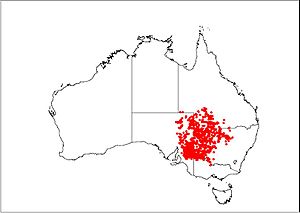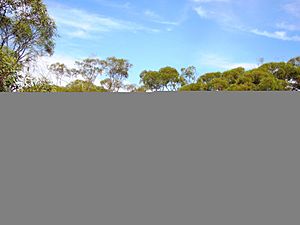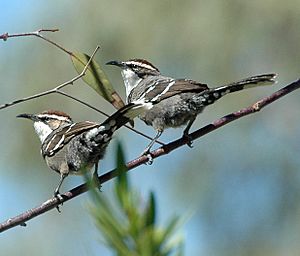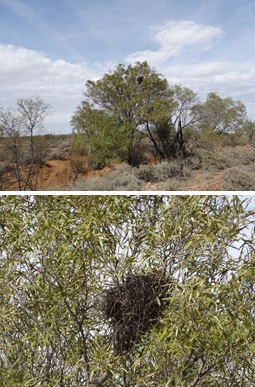Chestnut-crowned babbler facts for kids
Quick facts for kids Chestnut-crowned babbler |
|
|---|---|
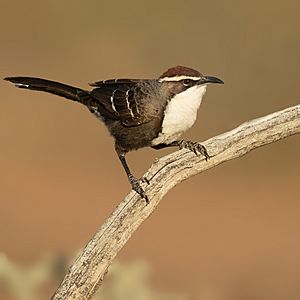 |
|
| Conservation status | |
| Scientific classification | |
| Genus: |
Pomatostomus
|
| Species: |
ruficeps
|
The chestnut-crowned babbler (Pomatostomus ruficeps) is a medium-sized bird found only in certain dry and semi-dry parts of south-eastern Australia. It belongs to a bird family called Pomatostomidae, which has five types of Australo-Papuan babblers. These birds are known for being noisy and very social. They live in groups of up to 23 birds. These groups search for food and raise their young together. People also call them red-capped babblers, rufous-crowned babblers, or chatterers.
Contents
- What Does a Chestnut-crowned Babbler Look Like?
- Where Do Chestnut-crowned Babblers Live?
- How Do Chestnut-crowned Babblers Behave?
- What Do Chestnut-crowned Babblers Eat?
- What Do Chestnut-crowned Babblers Sound Like?
- How Do Chestnut-crowned Babblers Breed?
- Who Hunts Chestnut-crowned Babblers?
- Are Chestnut-crowned Babblers Endangered?
- See also
What Does a Chestnut-crowned Babbler Look Like?
Chestnut-crowned babblers are dark, brownish-grey birds. They have a white throat and chest, and a tail with white tips. Their beak is long, black, and curves downwards. Their wings are short and rounded, and their tail is long and rounded at the end.
A special feature is their rich, chestnut-colored (reddish-brown) crown on their head. This crown is highlighted by long, white eyebrows. They have dark brown eyes and grey legs. Their wings, back, and sides are brownish-grey. The white area on their throat and chest is clear and narrower than on a similar bird, the white-browed babbler (Pomatostomus superciliosus). All these features give the chestnut-crowned babbler a unique look.
These babblers are about 21–23 centimeters (8-9 inches) long and weigh around 50 grams (1.8 ounces). This makes them noticeably smaller than the grey-crowned babbler (Pomatostomus temporalis). They also look slimmer than other babbler species. Adult male and female babblers look the same. Young birds look like adults but are duller. They have a pale reddish eyebrow, a brown crown, and a whitish patch behind their eye.
Where Do Chestnut-crowned Babblers Live?
Chestnut-crowned babblers live in inland areas of south-eastern Australia. This includes parts of western New South Wales, south-western Queensland, eastern South Australia, and north-western Victoria. Their home range is within the south-eastern Lake Eyre Basin and the western Murray-Darling Basin.
These birds often live in dry, open woodlands. These woodlands have trees like mallee, mulga, and belar. These areas are drier and more open than where white-browed babblers and Hall's babblers (Pomatostomus halli) live. They also live in acacia and cypress pine forests, stony areas, sandhills, and places with plants like lignum, saltbush, and samphire.
You can often spot chestnut-crowned babblers at places like Eulo Bore, Bowra Station, and in Hattah-Kulkyne National Park. They are also seen along many outback roads, such as those between Quilpie and Windorah, and Bourke and Nyngan.
How Do Chestnut-crowned Babblers Behave?
Babblers are famous for being cheerful, active, and very social birds. When they are not breeding (from December to June), chestnut-crowned babblers form close social groups. These groups can have 3 to 23 birds. They stay within their own territory, and they roost (sleep) and search for food together. They might also take dust baths and preen (clean their feathers) as a group.
At night, they huddle together in a special sleeping nest. The whole group builds this nest in dead or partly living trees. These "dormitory" nests can also be old breeding nests that the group keeps adding material to.
If something disturbs them, individual birds will hop away to hide. They then fly away in long, low glides. When they are worried, they might gather close together under thick leaves. Or they might quickly move up into the lower branches of trees and bushes, making loud chattering sounds. They are playful and have even worn paths in the ground from chasing each other. However, they are shyer than other babbler species.
What Do Chestnut-crowned Babblers Eat?
Chestnut-crowned babblers are usually seen hopping noisily on the ground. They also move through shrubs, over logs, and up tree branches. They dig and poke around in leaves on the ground and in cracks in tree bark. They are looking for insects and their young (larvae), spiders, small amphibians (like frogs), crustaceans (like yabbies), and reptiles (like small lizards). They also eat fruits and seeds.
They spend most of their day looking for food. They often do this in areas near water channels, which are thought to offer more hiding places from predators and more food. They are not known to catch flying insects in the air.
What Do Chestnut-crowned Babblers Sound Like?
These birds have a strong, uneven, but musical song for their territory. It sounds a bit like the piping call of the little eagle (Hieraaetus morphnoides). They sing from the top of a tall mulga tree or another high spot.
There is constant chattering among the group members. This includes whistling calls mixed with 'tchak-tchak-tchak' sounds. These sounds get louder and more frequent when the birds are excited, arguing, or alarmed. The call they use to keep in touch with each other in the group is a whistling 'tsee-tsee, tsee-tsee'.
How Do Chestnut-crowned Babblers Breed?
Breeding usually happens between July and November. Their nest is large and easy to see. It's a dome shape, about 50 centimeters (20 inches) across and almost 100 centimeters (39 inches) high. They build it in a forked tree branch, 4–10 meters (13-33 feet) above the ground, using long sticks. Their nests are bigger, neater, and often higher than those built by white-browed babblers. They also use finer sticks. Old nests can be made bigger and used again.
Their eggs are about 27 x 19 millimeters (1.1 x 0.7 inches). They are pale grey-brown, oval-shaped, and covered with fine, dark lines. A female usually lays 2-6 eggs. The young birds leave the nest after 21–25 days. Sometimes, a nest might have an unusually large number of eggs. This can happen if more than one breeding pair uses the same nest.
How Do They Cooperate to Raise Young?
The chestnut-crowned babbler is a cooperatively breeding bird. This means that more than just the parents help raise the young. Each group has one breeding pair (a male and female that mate) and other birds called 'helpers'. These helpers are usually younger birds or relatives. They provide care, especially by bringing food, to young birds that are not their own.
The whole group works together to build the nest. They also help feed the female bird while she is sitting on the eggs. And they defend their breeding territory. It's very rare for a breeding pair to try to raise young without help, and it's usually not successful for this species.
Scientists have studied why these birds help each other. One important reason is called kin selection. This means that helping relatives (like brothers, sisters, or cousins) helps pass on shared genes, even if the helper doesn't have its own chicks. Living in larger groups also helps the young survive better. For example, bigger groups are better at spotting predators.
Most social groups of chestnut-crowned babblers split into smaller breeding units during the breeding season. Each unit focuses on one nest. After breeding, these units join back into larger groups. The size of the breeding unit is very important for how many chicks survive. For every three helpers in a group, one extra chick is likely to fledge (leave the nest). This shows how important helpers are, especially in their tough environment.
Who Hunts Chestnut-crowned Babblers?
Chestnut-crowned babblers live in open areas, which makes them easy targets for birds that hunt from the sky. Groups are more likely to be attacked by these bird predators when they have young birds that depend on them. Larger groups are more likely to meet predators, but they are less likely to be attacked.
Some birds that might hunt them include the brown falcon (Falco berigora), peregrine falcon (Falco peregrinus), Australian hobby (Falco longipennis), brown goshawk (Accipiter fasciatus), and collared sparrowhawk (Accipiter cirrhocephalus). When these birds fly close to a group of babblers, the babblers will make loud alarm calls.
Are Chestnut-crowned Babblers Endangered?
Around the world, the chestnut-crowned babbler is listed as "least concern" by the IUCN Red List. This means it is not considered to be at risk of extinction. It is also not listed as threatened under Australia's national Environment Protection and Biodiversity Conservation Act 1999 or under laws in Queensland, New South Wales, Victoria, or South Australia.
We don't know much about how far they move, but these birds are thought to stay in one area. They are found in some places, but not very common in others.
See also
 In Spanish: Pomatostomus ruficeps para niños
In Spanish: Pomatostomus ruficeps para niños



